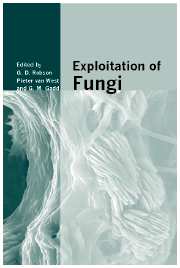Book contents
- Frontmatter
- Contents
- List of contributors
- Preface
- I Comparative and functional fungal genomics
- II Bioactive molecules
- 3 The biosynthesis of polyketides, acyl tetramic acids and pyridones by filamentous fungi
- 4 Fungal metabolites as lead structures for agriculture
- 5 Molecular and genetic analysis of symbiosis expressed secondary metabolite genes from the mutualistic fungal endophytes Neotyphodium lolii and Epichloë festucae
- 6 What can genomics tell us about secondary metabolism in Aspergillus?
- III Protein folding and secretion
- IV Fungal bioremediation
- V Fungal biocontrol of pests
- Index
- References
3 - The biosynthesis of polyketides, acyl tetramic acids and pyridones by filamentous fungi
from II - Bioactive molecules
Published online by Cambridge University Press: 05 October 2013
- Frontmatter
- Contents
- List of contributors
- Preface
- I Comparative and functional fungal genomics
- II Bioactive molecules
- 3 The biosynthesis of polyketides, acyl tetramic acids and pyridones by filamentous fungi
- 4 Fungal metabolites as lead structures for agriculture
- 5 Molecular and genetic analysis of symbiosis expressed secondary metabolite genes from the mutualistic fungal endophytes Neotyphodium lolii and Epichloë festucae
- 6 What can genomics tell us about secondary metabolism in Aspergillus?
- III Protein folding and secretion
- IV Fungal bioremediation
- V Fungal biocontrol of pests
- Index
- References
Summary
Introduction
The filamentous fungi are proficient and copious producers of secondary metabolites. From the perspective of an organic chemist, the range and variety of chemical structures of these compounds is remarkable. Synthetic organic chemists have often used the very high structural complexity of fungal secondary metabolites to test their own abilities to mimic nature. From the perspective of a medicinal chemist, the diversity of compounds and structural types represents a pool of useful compounds often possessing unique biological properties. The range of structural types can, at first, appear baffling. However, most secondary metabolites produced by fungi fall into a relatively small number of classes: the alkaloids, derived from amines and amino acids; the terpenoids, derived from isopentenyl diphosphate; and the polyketides, generally derived from acetate. This system of classification is based on the biosynthetic origin of the compound in question, that is to say, a combination of the type of starting material and the type of chemical reactions used during biosynthesis. However, fungi also often combine different types of biosynthetic pathway during the manufacture of secondary metabolites. In Bristol, we have focused our efforts on understanding the biosynthesis of polyketides in fungi, but the inclusion of amino-acid derived moieties in the compounds we are interested in has also necessitated wider investigations.
- Type
- Chapter
- Information
- Exploitation of Fungi , pp. 25 - 44Publisher: Cambridge University PressPrint publication year: 2007



